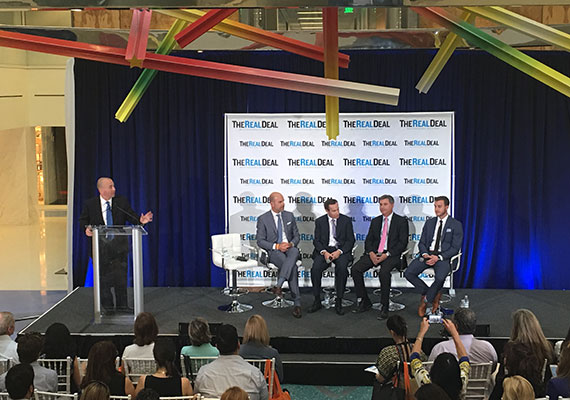Trending
Demand in Broward County still rising: TRD panel
Experts speak on Broward buyers, new development, transit and presidential election

As Miami’s real estate market loses some of its heat, Broward County is maturing as a hotspot of new development in South Florida, according to a panel of experts at The Real Deal’s Broward Showcase and Forum on Thursday.
The “Broward Deep Dive” panel, one of two at the event at the Design Center of the Americas in Dania Beach, focused on analyzing Broward County’s hottest markets and comparing them to their biggest competitors in Miami-Dade County.
“Our economy both in the county and in the state of Florida lives and dies with the real estate industry,” said Broward Mayor Martin Kiar, who gave a keynote address before the panel began. “When the real estate economy is booming, our local economy is booming.”
And indeed, the industry seems to be booming in Broward: of the 417 buildings and 51,000 residential units in South Florida’s pipeline, 19 percent are in Broward, according to figures cited by panel moderator Peter Zalewski, a TRD columnist and founder of research firm CraneSpotters.com.
A big part of that development upswing is due to the Related Group, a firm famous for cranking out luxury buildings in Miami.
“When we first launched [Auberge Beach Residences Fort Lauderdale] a year ago we didn’t know what to expect,” said panelist Patrick Campbell, vice president of Related. What we found is there is a local market; 85 to 90 percent of our sales are local end users.”
But some of the company’s uncertainty about Broward still holds over today. Related is still trying to determine whether its Icon Las Olas development should be rentals or condos, Campbell said. And at the company’s New River Yacht Club project, the company might launch phase three sooner than phase two, purely because 190 units will be easier for the market to absorb than 350.
“With the pace of sales in Broward, we want to let the market decide.” he said.
One major difference between Broward and Miami is the demographics of buyers: Campbell said a lot of sales come from empty nesters in the county’s western suburbs looking to downsize, while also buying luxury units now that they can afford it.
They’re tough sells though, he said, and a closing that would’ve taken days in Miami could take 60 days as the Broward buyers vet everything from the finishes to the location.
Jean Francois Roy, founder of development firm Ocean Land Investments, is tapping into that same demographic with his nearly half-dozen condo projects in the luxe neighborhood of Las Olas.
“After the last recession, we decided to specialize in Broward County,” Roy said.
He said there’s actually not that much development happening in Broward — at least compared to Miami — largely due to expensive land prices and the lack of favorable development sites.
That, in part, is why commissions for realtors tend to be lower than in Miami, as there just aren’t as many projects to sell, he said.
Several of the panelists agree transportation could play a huge factor in helping Broward’s real estate market grow.
Jaime Sturgis, sales director for Metro 1’s Broward office, said commercial prices in Fort Lauderdale and especially in the hip neighborhood of Flagler Village are poised to rise as new commuting options emerge for residents. All Aboard Florida is set to launch its Brightline line next year, with trains running between Miami, Fort Lauderdale, West Palm Beach and Orlando. Fort Lauderdale is also considering a proposal for the Wave street car, a commuter service similar to the in-ground trolleys of San Francisco, Sturgis said.
“Transportation is the crutch we all lean on in the urban core,” he said. “As that gets better and we have alternative modes of transportation, we can build this density with 42 projects coming online [in Flagler Village], and with that comes all the creative retail.”
Harvey Hernandez, president of Newgard Development Group, is exploring that car-less concept with one of his newest projects: Centro in downtown Miami, which has no parking component.
“Every deal that we’re looking at is pushing the envelope as far as parking reduction,” he said. “Not because of costs, because… what are we’re going to do with these garages that nobody is going to use? The next few years, we’ll probably see a lot of more these buildings with no parking.”
The panelists even weighed in on this year’s presidential election and how it affects the local market.
“I’m gonna stay away from the question of who I think should be the president,” Related’s Campbell said, conceding that he “can’t wait for it to be over. Once there is an election, for good or for bad, it’ll give some certainty to the world.”
Hernandez, on the other hand, was a little more direct: “I think the best guy to be elected is none of the guys, so we’re hoping a miracle happens.”




